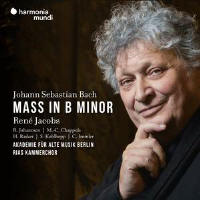Texte paru dans: / Appeared in: |
|
|
Outil de traduction |
|
|
There are few major choral works that ‘period’ directors tend to revisit in the studio as regularly as the Mass in B minor. If Gardiner, Brüggen, Harnoncourt and Herreweghe’s individual braces of recordings reveal no particular move from the studied towards the more confidently expressive, the later versions tend towards a greater refinement in the pacing and characterisation of Bach’s superlative anthology. With René Jacobs, the matter is less clear-cut. While he brought his own dramatic and rhetorical instincts to bear in his reading of 1992 with the same orchestra and choir, the effect was often uneven and comparatively unsure compared to his secular cantata recordings soon after. This new account is dedicated to the memory of Eva Coutaz who, with her husband Bernard as founders and proprietors of Harmonia Mundi, shepherded Jacobs through his many distinctive discographic excursions over the decades. It presents a significant departure from his performance of 30 years ago. In particular, Jacobs explores with commitment and imagination the play between a tutti and solo chorus, and in doing so (supported by a pithy if potent note) he slams the door shut on the oneto-a-part brigade as a ‘dubious passing fad … with misinterpreted historical facts’. Taking Wilhelm Ehmann’s musicology and Praetorius’s preface to Syntagma musicum (1619) as signposts, a ‘vocal concerto’ of greater or lesser forces is projected on to a canvas full of twists and turns. In effect, the chamber choir sing the big stile antico choral numbers, a smaller ensemble of singers (from within the choir) perform those sections that are deemed more concertante than tutti (or stylistically ‘modern’), and the soloists sing the ‘arias’ and duets, and a few glaringly madrigalian movements (‘Qui tollis’ and ‘Crucifixus’) or ‘riffs’ in the choruses (‘Et iterum venturus est’ in the ‘Et resurrexit’). It’s a speculative but nonetheless musically motivated exercise and yields some pleasures, if not revelations. For all the urbanity of these vocal allocations, however, the project is let down by the recorded sound, which is overreverberant, and thin and hard-edged for the solo voices – evident right from the ‘Christe eleison’ and a hollow-sounding ‘Laudamus te’ – and without the richly varied and resonant instrumental perspectives of the more au courant practices employed by the likes of Pygmalion and Vox Luminis. It makes for an exhausting experience, especially in the predominant D major trumpet-led ensembles with the failure to capitalise on the textural character of the singers and instrumentalists. It is perhaps not helped by Jacobs’s lack of rhythmic grip; such are the fluctuations in the ‘Et resurrexit’, it’s hard to know what tempo has been settled upon. In general, misgivings from Jacobs’s previous reading are not eroded as much as one would have hoped. He plods through some of the most luminous music, including the peerless ‘Et in terra pax’, where the singing from the RIAS Kammerchor lacks shape and line. The ‘Cum Sancto Spiritu’ rocks, but not in the right way, and the ‘Credo in unum Deum’ is a dour and lifeless affair. Among a number of downbeat allegro movements, the ‘Sanctus’ is performed presto: it provides a decidedly comical aside to proceedings. Some of the later movements are more engaging: Jacobs has the special measure of the ‘Crucifixus’ with some affecting coloration, and Christian Immler’s ‘Et in Spiritum’ is exceptionally poised and affectionately delivered. In an almost universally disappointing account of the Mass, these are perhaps the only movements that convey the spirit, lightness, shading or brilliance of execution of the directors listed above. I should also add Lars-Ulrik Mortensen’s and Jonathan Cohen’s compelling readings (respectively CPO, 3/16 and Hyperion, 11/14) over the past decade. |
|




